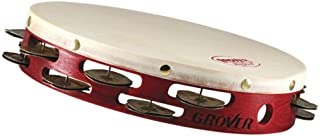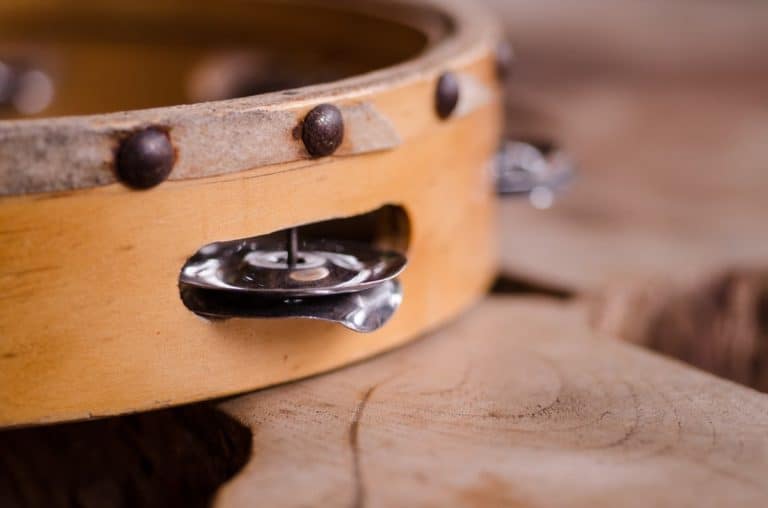Can Anyone Play Tambourine? | Simple Tips
A tambourine looks like a pretty simple instrument in the hands of Phil Collins or Liam Gallagher but are they as easy to play as they look?
How hard is it to play Tambourine? – It is not as easy as it might look at first glance and will require practice, technique, and patience to master. A sense of rhythm and an ear are essential tools. Once you’ve got them down it’s a breeze but there is a lot more to playing the tambourine that just shaking!
Let’s delve into Tambourine playing and find out why it is not as easy to play as it looks and how it can be important to understand the technique.
How To Be a Better Tambourine Player
First of all, remember that there are many different types of tambourine, but for the most part, any references here are to either the headed tambourine [with skin] or the headless version, popular in rock bands.
I shall run through, in as much depth as possible the various elements required to play tambourine. And don’t worry, whilst I opened with a warning that playing tambourine is not as easy as you might think, with no notation to learn, it’s a lot easier than the Harp!!
How to Hold a Tambourine
There are many theories on how a tambourine should be held but in truth, it should be held to suit what sound you are trying to achieve. Holding your tambourine at different angles will affect how it sounds. a 45-degree angle allows some ring from the jingles, but for more ring, hold it at 90 degrees especially when performing a roll.
QUICK TIP: A roll is when you roll your thumb around the jingles. More below
Which hand should I hold a Tambourine in?
When you pick up a tambourine for the first time, your natural instinct is to hold it in your dominant hand, but in fact, you want to hold it, in the other. This allows you to play the rhythms on the head with your better hand.
How to Hit a Tambourine Properly
Depending on which type of music you listen to or watch, it could depend on what you think is the correct way to play. A lead singer in a rock band may be smashing the tambourine on their hip whilst a player in an orchestra would never be found using that technique, rather, holding it at a 45 or 90-degree angle at eye level in line with the conductor.
So beyond the hip strike, what other strikes should be used?
You can form a fist and strike the tambourine around one inch from the rim. [Never strike with your knuckles, just the flat part], Try decreasing the number of fingers in the fist and experiment with the sounds that it produces.
You will notice softer and harsher, louder and quieter effects by doing so, apply as required for the passage of music you are accompanying
You can also place the tambourine on your thigh to play. You will need to raise your foot up onto a stand or a chair for example. Secure the tambourine with your forearms on the nearside, the side closest to your body, and you have two hands-free now, to play the tambourine on the far side one inch in from the edge.
Playing Tambourine in a Stand
You may want to add a tambourine to your drum kit and mount it in a stand. I expect if you have searched google and arrived at this article, you’re not already a drummer. Just a feeling.

So I shan’t go deep into this subject other than to suggest a mounted tambourine another option in learning all round tambourine playing skills.
Tambourine Rolls
There are two types of roll you can play, one involving a controlled shake of the tambourine, the other, a more manual process using a thumb or find around the jungles.
Tambourine Shake Roll
The shake roll is pretty much as it sounds. You’ll take the tambourine and shake it from the wrist as if you were shaking a bottle of sauce before opening or turning a doorknob back and forth very quickly. You can also affect the roll by keeping your wrist stable and shaking your elbow, but that is a tricky technique to master.
The aim of the shake roll is to sustain the jingles in a single sound for as long as it is required for what you are playing.
Tambourine Thumb Roll
Another roll is known as a thumb roll but in reality, you can use any digit.
Thumb Roll Tip: A quality professional Tambourine is going make thumb-rolling a lot easier, as it will produce better friction [with a wet thumb or beeswax] far better than a budget tambourine with poor head materials.
It goes without saying that a child’s tambourine or a cheap version is not going to perform as well as a professional instrument. This Remo Fiberskyn Tambourine on Amazon is at the lower end for budgets but is a great example for beginners.
You’ll take the tambourine and roll your thumb around the edge of the tambourine affecting the jingles to produce the sound
How Long Does it Take to Learn Tambourine?
Many a concert tambourine player will claim you never stop learning, but to begin playing and keeping time with your tambourine should not take too long at all. Pick a suitable piece of music and start shaking and tapping alone
You can begin making sounds the moment you pick up a tambourine. In fact, those jingles are going to start the second you touch it! The knack is in getting it to make the right sounds at the right time and that’s the tricky part.
If you have an OK sense of rhythm you will be able to start to strike and shake your tambourine straight away. Good timekeeping is pretty essential with any musical instrument and the tambourine is no exception
Keeping Time with Tambourine
One of the most popular ways of keeping time with a tambourine is by holding it vertically to the ground and exercising a left and right motion. Mostly you will find a lead singer in a band playing in this fashion if not popping against a hip or leg.
Tambourine Practice Routines
These are basic practice modes for the beginner
Decide upon a holding hand and playing hand. Generally, the holding hand will be the non-dominant hand. When practicing, you will likely be playing with the tambourine on the horizontal. Just angle it slightly or ideally to 45 degrees, this enure the jingles mute, rather than sustain on the flat side.
As mentioned with keeping time above, try shaking the tambourine left and right, do that a few times. Try to ensure you are keeping good time, perhaps introducing a metronome at different speeds to see how you cope at slower or faster tempos.
Once you feel comfortable, and feel you are keeping good time with the left and right motion, you can begin to introduce the playing hand and striking it on every other shake. You will begin to notice the beats changing.
Check out the Tambourine Roll Sections above, and try practicing the wrist rolling shaking action. It sounds quite easy but when doing it for the first tie, give it a few minutes and you find your wrist beginning to ache. This is where regular practice comes in to build up some stamina in your wrist flexor muscles.
There are lots of instructional videos on YouTube to learn new techniques and practice routines.





![Best Percussion Instruments For Kids [That you can play too]](https://cdn-0.coolpercussion.com/wp-content/uploads/2020/09/woman-4010110_1920-768x512.jpg)
![Tips for Recording Tambourine [Instruments – Microphones]](https://cdn-0.coolpercussion.com/wp-content/uploads/2021/02/recording-tambourine-768x512.png)
